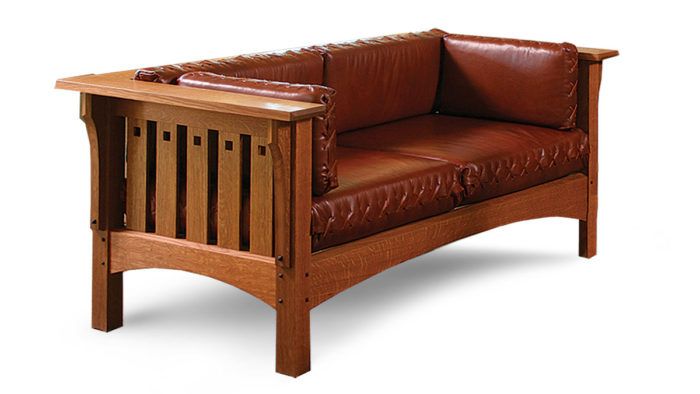
By Kevin Rodel #199–July/Aug 2008 Issue
Synopsis: Kevin Rodel’s prairie settle is a perfect example of the low horizontal lines that characterize Prairie-style furniture. The broad low back is well suited for informal conversations. The generous use of wood around the sides and back opens up many design possibilities for creating a beautiful and functional room divider. Construction is of simple mortise-and-tenon joinery, and the dimensions can be changed easily to fit into different room sizes and furniture groupings. The corbels, which add a decorative flair, are the most complicated part, but they can be made quickly and consistently using Rodel’s technique.
This settle is a perfect example of the low horizontal lines— reminiscent of the broad horizon of the Midwest—that characterize Prairie-style furniture. Even though the heyday of the Prairie school of architecture and furniture (largely credited to Frank Lloyd Wright) lasted only from about 1900 to 1915, the strong lines and characteristically unadorned style make it as popular today as it was back then.
The basic form is classic, but a few details make this settle uniquely mine. I added the scoop-out on the feet, the hip-roof shape on the arms and corbels, the pyramid-head pegs, and the slight extension of the back of the side arms beyond the long arm. But the most distinctive part of this settle is the square cutouts in the slats.

Although the overall size and the number of parts involved make this piece seem like a more advanced project, it’s very straightforward. Most of the construction involves simple mortise-and-tenon joinery. The corbels are the most complex part, but I’ll show you an easy way to make them quickly and consistently.
The dimensions of the piece are standard to the period and type of furniture but can easily be changed to accommodate different body types or room sizes. The height of the settle can be adjusted by changing the length of the leg posts and the placement of the horizontal pieces. The length is modified by changing the length of the long rails and the number of slats in the back and/or the spacing between them.
There are upholstery options to consider: attached, integral spring-form cushions, or loose cushions. I like the loose cushions because the upholstery method is easier for an amateur. If you use fabric covers, you’ll need an upholsterer to sew the cushions. If you use leather, you can have an upholsterer sew them or lace them yourself, as I demonstrate on Finewoodworking.com.
While this settle is made of quartersawn fumed white oak and is upholstered with leather, don’t feel limited by my choices. the form’s strong lines and a wide choice of fabrics allow this piece to look great in almost any wood species and in a variety of settings.
It is difficult to find quartersawn 12/4 oak, but if the posts have a face with ray fleck, I put it on the sides of the piece, so the nicest faces can be seen in pairs. After dimensioning the posts, lay out the mortise locations and corbel grooves as well as the stub tenon shoulder line.
See how he upholsters the piece in a three-part video series.
From Fine Woodworking #199
For the full article, download the PDF below:
Sign up for eletters today and get the latest techniques and how-to from Fine Woodworking, plus special offers.